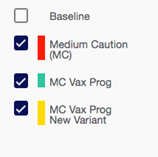COVID-19 Policy Simulator and Learning Environment
Public Outreach Division
Department of Disease Control (DCD)
Ali Mashayekhi, Emeritus Sharif University of Technology
Dan Gordon, Retired
NYS Department of Health
David Andersen, Emeritus
University at Albany-SUNY
Luis Luna-Reyes
University at Albany-SUNY
Part 5: What Happens when New Variants Arrive (think Delta and Omicron variants)
Working through the first four parts of this simulation manual, we have stressed several general lessons:
- A pandemic controlled by nature, herself, would sweep through the human population causing widespread sickness and death. No one knows for sure how bad it would get to be, but as we have discussed in Part 2 above, Cumulative Sickness for the US population as a whole in this hypothetical “what if” scenario could be as high as 230 million or more and we might be facing between 5 and 6 million deaths. Without human countermeasures a pandemic would administer a truly cruel toll on the human population.
- Humans respond to a threshold point when deaths start to rise and at that point start to be more cautious, wearing masks, staying home with self-imposed quarantines, or even responding with government-imposed lockdowns and contract-tracing programs. So, human behavior is a complicated combination of what humans choose to do on their own and what they are mandated to do by government-sponsored public policies. Over time, humans revert to their “business as usual” patterns as deaths start to recede. As we have seen in Part 3, these two patterns of human behavior combine to set up a long-term pattern of repeating surges until something changes (such as we reach the ever-elusive herd immunity, or a new and less dangerous variant emerges).
- As we saw in Part 4, vaccines can help a human population leap quickly toward herd immunity, decreasing the number of susceptible persons to be infected by each sick person. Overall, we characterized programs of vaccination by (a) overall effectiveness in preventing infection and hospitalization (and ultimately death), (b) The fraction of the population that is willing to take the vaccine, and (c) how long it takes to lose immunity (which in the real world is linked to the need for subsequent booster shots).
This section of the Learning Environment examines a scenario where a more infective variant of the virus appears. In the real world, emergence of worrying new variants is determined by the interactions of complex biological process with human behavior and we make no attempt simulate it within our simple model. We treat the emergence of a new variant as an exogenous event that is specified by the modeler. This is similar to how our model treats vaccinations. In Ali’s model as currently configured, the time when vaccination capacity and new variants occur is determined by the modeler1. You, the modeler, can use this power to test the consequences of your assumptions and explore novel scenarios.
As you make your next set of runs within this simulator, here are several caveats:
- Caution:Ali’s model does not really have any variants built into it. Rather a variant is modeled by changing Infectivity – the likelihood of transmission from an infected person to a susceptible one during a contact event – and, possibly, the case fatality rate (that option is not made available to you). The new default variant in the simulator has infectivity = .1, 2.5 times the infectivity in the Base Run. This is about the same as a Delta-like variant.
- The timing of the variant is exogenous. This means that you decide when and if a variant appears. The “base” new variant appears at day 450 and has fully taken over by day 550.
- It is probably most interesting to test a new variant after a vaccine has been introduced, though you could also introduce a new variant before vaccines are introduced, if you wish.
Make Three Simulations to Understand More about a New Variant. The following set of runs will get you started in thinking about how new variants impact the overall pandemic system:
- Medium Caution Social Response. You have already seen this run. This is the run where human behavior coupled with the surge-creating dynamics of the pandemic itself create a pattern of smaller, repeating surges over a long period. Repeat that here to get a base run against which you can compare a similar run with vaccination and another one with vaccination plus a new variant.
- Medium Caution Social Response with Vaccination. This run is the same as the one above except that in the Mode 2 screen you push the button to activate the vaccination program. (Don’t forget to check the Effectiveness and Willingness settings.) Comparing these first two runs will show you the “what if” of a successful vaccination program.
- Medium Caution Social Response with Vaccination and New Variant. Keeping the same settings as the previous run, turn on the New Variant option. Comparing this run to the just previous run will show you “what if” a new Delta-like variant arrives just as the vaccination program is starting to succeed.
Making these three runs reveals some very interesting and puzzling layers of dynamics within the COVID-19 pandemic system. Our team first made runs like these in the late summer of 2021 when virologists were first reporting the possible arrival in the U. S. of the Delta variant that had emerged in South Africa. One of our stories from that time used these runs to explain why people (and governments, even) got so confused about how to behave in those months. Even the CDC had flip flopped on its recommendations about remaining masked while at public indoor gatherings. You can read that full story here.
The key runs, like those in our story, produced by this simulator and are shown in Figure 6 below:

Figure 6: Adding vaccinations to a Medium Caution population stabilizes Death Rate (Green line). Reintroducing a Delta Variant starting Day 450 recreates periodic surges (Yellow line)

We’ll look closely at the Death Rate, but the Incidence Rate graph tells a similar story. Before day 200, all three runs in Figure 6 follow exactly the same trajectory and hence show up only as the last (YELLOW) line. The lines are the same before day 200 because in all three scenarios before that time there was no effective vaccination program (the simulated vaccination program just got started at day 180) nor any new variants (the new variant started to appear at day 450). The RED line shows what the model predicts would happen in the absence of vaccinations or a new variant. It shows the pattern of repeating surges associated with a population exhibiting medium caution as its social response.
The GREEN line shows what happened if an effective vaccination program comes online, starting at day 180. Between days 180 and 450, the GREEN and YELLOW lines overprint each other. The GREEN line shows the pandemic starting to settle into a stable endemic pattern.
The YELLOW line shows what the model predicts would happen if a new Delta-like variant emerges starting on day 450. In this run the stabilizing effect of the vaccine program is canceled out by the increased infectivity of the new variant, leading to a new pattern of repeating surges. The peaks of the YELLOW curve seem to be lower than the peaks of the RED curve, but the areas under the curve of each peak are actually quite similar. (Note that while the YELLOW peaks are lower, the troughs are higher.) That’s why Cumulative Deaths rise at a similar rate for the Medium Caution scenario and for the Medium Caution with Vaccination and New Variant scenarios. Again, the beneficial effect of the vaccination is being negated by the adverse effect of the new variant.
While the time scale in Ali’s model is an abstract counting of days since the start of the pandemic, if you overlaid his time scale on an actual calendar, day 480 in the model would probably have occurred some time during the late summer of 2021. Remember, that the modeler team exogenously forced this to happen by having the new variant start at day 450.
Crafting public policies around day 480 (that is during the summer of 2021) is difficult. The dynamics of the epidemic are layered, with competing causal forces creating a complex pattern of surges and remissions. The “natural history” of the baseline pandemic, human behavior and countermeasures, the vaccine program and a new, aggressive variant are all operating at the same time. 480 days into the pandemic is a tough time to be making public policy.
Your Next Task. If you have been doing a good job following the lessons and insights that we have been going over in these five parts to this manual, you should now try your hand at crafting a set of policies that can stabilize the COVID-19 pandemic that is raging within the simulation.
Alas, taming a pandemic in a simulated learning environment is much more possible and simpler than in the real world. Good luck!

